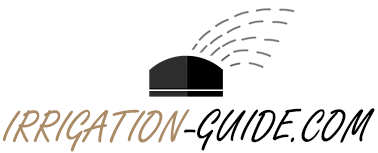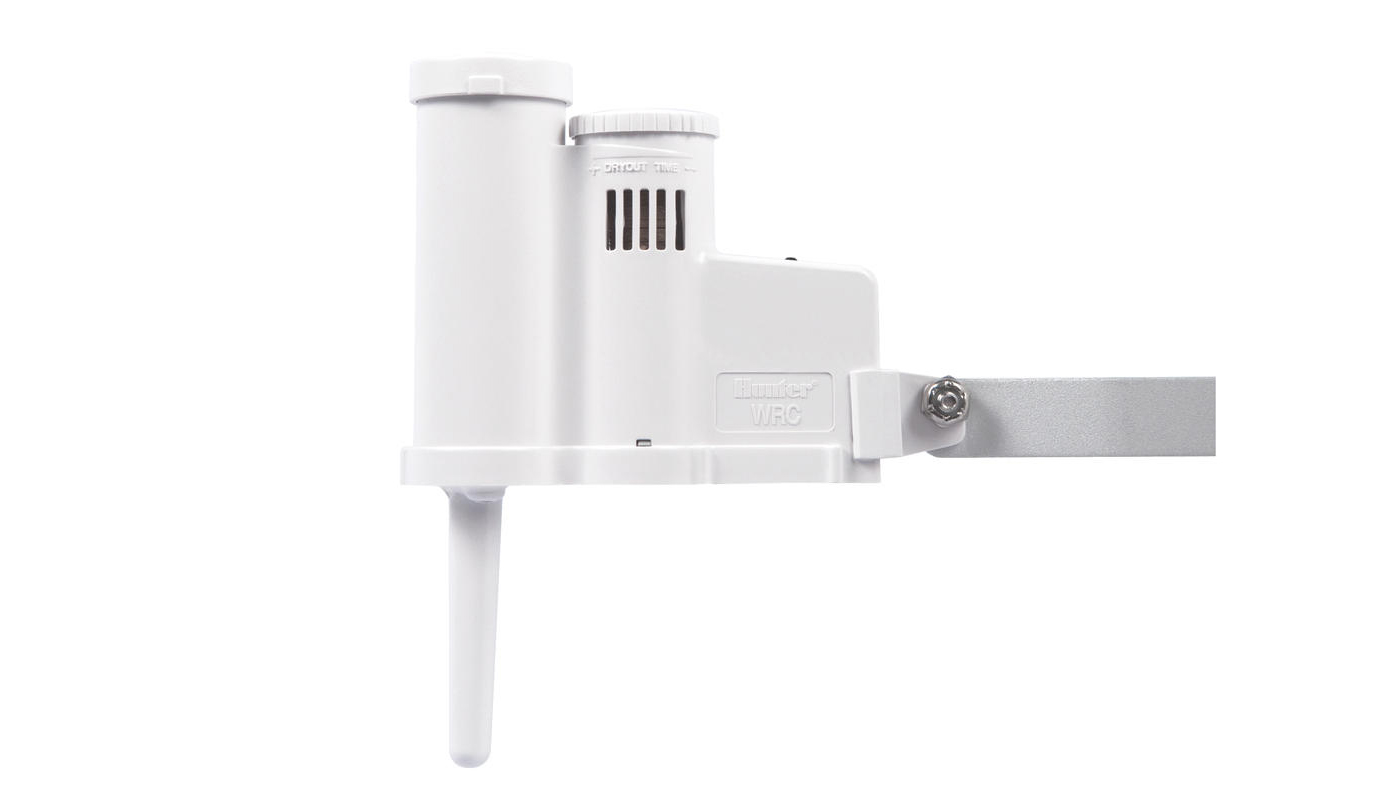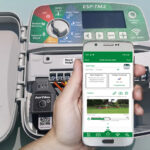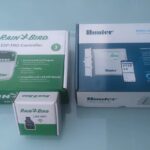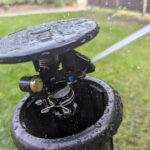Sensors give you the ability to dynamically adjust irrigation to local conditions. On the one hand, this allows irrigation to be perfectly tailored to the requirements of the lawn and plants, and on the other hand, it helps to save water and you don’t have to worry about manually adjusting the irrigation to the seasons and weather conditions. This blog post gives you an overview of the different types of sensors, how they work and which products are available on the market.
Rain Sensors
There are two types of rain sensors:
- Rain sensors that use a lens to optically register when it rains and as a result prevent the planned irrigation from starting or stop an irrigation run that has already started
- Rain sensors that measure the amount of rain that has fallen and, if this exceeds a certain value, ensure that the irrigation is suspended. This is done by the sensor sending an off pulse to the irrigation computer as soon as the limit value is exceeded. With most sensors, the limit value can be set individually, with the Rain Bird RSD, for example, between 0.12 and 0.75 inches of rain. The setting you make depends on the planned frequency of watering and the water requirements of the area to be watered. With modern sensors, the amount of rain is no longer measured directly by measuring the amount of rain collected, but with the help of a cork-like material built into the sensor, which collects the liquid and expands the wetter it gets. When the rain stops, it dries up again and gradually shrinks back to its original size. Only when it falls below a specified value is the suspension of the irrigation ended again by the sensor no longer sending the off impulse to the irrigation computer. The programmed irrigation program is then continued. It is important to mount the sensor on an open, unprotected area so that the rainfall is the same as the rainfall that arrives on the area to be irrigated. The solar radiation should also correspond to that of the irrigated area: If the irrigated area is in the sun most of the time, for example, then the sensor should also be installed in a similar place so that the evaporation also corresponds as closely as possible to the actual conditions.
The first type described, which works with optical means, is now outdated and is hardly offered anymore. In this category I would only know the electronic rain sensor from Gardena. The second type includes the Rain Bird RSD, the Hunter Mini-Clik and the Hunter Rain-Clik. The Rain-Clik differs from the other two rain sensors in the built-in “Quick Response” function. This causes the sensor to stop irrigation almost immediately in the event of rain. Depending on the weather, irrigation is interrupted in such a case for 3 minutes to 4 hours. The Rain Bird Sensor and the Hunter Mini-Clik, on the other hand, only do this at the moment when the set limit has been exceeded. Everyone has to decide for themselves whether this is an advantage or not. The main argument for the Hunter Rain-Clik’s Quick Response function is that the neighbors don’t look funny when you water when it’s raining. On the other hand, even a short drizzle causes irrigation to stop. In the case of weekly watering, this can mean that the lawn remains practically without water for a week. The lawn may then not receive the necessary minimum amount of water and be damaged. The Rain Bird RSD and Hunter Mini-Clik, on the other hand, only stop when the limit value is reached, so it can also happen that there is parallel irrigation during a heavy downpour. The sensors only interrupt when the limit value is reached.
Can the rain sensors be used across manufacturers?
Most rain sensors work on the same “normally closed” principle. As long as the sensor is dry and the threshold value has not been reached, the sensor circuit is closed. Only when the threshold value is exceeded, i.e. the rain sensor is triggered, is the circuit opened and the connection to the solenoid valves interrupted -> the signal for sprinkling is not received. Only when the wetness in the sensor is so low that the circuit is closed again is the connection to the solenoid valves restored and irrigation can be carried out again. The three previously presented Rain Bird RSD, Hunter Mini-Clik and Hunter Rain-Clik, for example, work according to this principle and can therefore also be used with irrigation computers from the other brand. Hunter also states that its Rain-Clik sensor can be used with most irrigation computers.
Of course, this compatibility does not apply to manufacturers whose rain sensors work according to a completely different principle, such as Gardena.
Wireless rain sensors
The sensors listed above are sensors that are connected to the water computer via a cable connection. Alternatively, models that work wirelessly are also available. The impulse from the rain sensor is sent wirelessly to an additional wireless receiving station that is installed near the water computer and then forwards the signal to the computer via a cable connection.
Rain sensors at Amazon
Following are Amazon links to some of the wired and wireless rain sensors presented.
Wired rain sensors
| Hunter Mini-Clik | Hunter Rain-Clik | Rain Bird RSD | |
|---|---|---|---|
Auto Amazon Links: No products found. |
Auto Amazon Links: No products found. |
Auto Amazon Links: No products found. |
|
| Type | Rain Sensor | Rain Sensor | Rain Sensor |
| Setting option | Threshold can be set between 1/8 and 1 inch of precipitation. | If it rains up to 1/8 inch, the quick response blocking is automatically triggered, and from 1 inch the long-term blocking (until the cork dries). The drying time can be influenced by adjusting ventilation slots. | Threshold can be set between 1/8 and 3/4 inches of precipitation. The drying time can be influenced by adjusting a ventilation ring. |
| Working principle of the sensor | Available in a normally closed or normally opened version | Available in a normally closed or normally opened version | Normally closed and normally opened |
| Toro 53769 Wired Rain Sensor | Orbit 57069 Hard Wired Rain and Freeze Sensor | Irritrol RS500 Wired Rain Sensor | |
|---|---|---|---|
Auto Amazon Links: No products found. |
Auto Amazon Links: No products found. |
Auto Amazon Links: No products found. |
|
| Type | Rain Sensor | Rain Sensor | Rain Sensor |
| Setting option | Threshold can be set between 1/8 and 1 inch of precipitation. | Threshold can be set between 1/8 and 1 inch of precipitation. | Threshold can be set between 1/8 and 3/4 inch of precipitation. |
| Working principle of the sensor | Normally closed and normally opened | Normally closed and normally opened | Normally closed and normally opened |
Wireless rain sensors
| Hunter Wireless Rain Clik | Rain Bird WR2 | Irritrol RS1000 Wireless Rain Sensor | |
|---|---|---|---|
Auto Amazon Links: No products found. |
Auto Amazon Links: No products found. |
Auto Amazon Links: No products found. |
|
| Type | Rain Sensor (Wireless) | Rain Sensor (Wireless) | Rain Sensor (Wireless) |
| Setting option | If it rains up to 1/8 inch, the quick response blocking is automatically triggered, and from 1 inch the long-term blocking (until the cork dries). The drying time can be influenced by adjusting ventilation slots. | Threshold can be set between 1/8 and 1/2 inch of precipitation. Quick Shutdown suspends the active watering cycle within two minutes. There are three working modes to choose from. | Threshold can be set between 1/8 and 3/4 inch of precipitation. |
| Working principle of the sensor | Available in a normally closed or normally opened version | Normally closed | Normally closed and normally opened |
Soil Moisture Sensors
Soil moisture sensors go one step further than rain sensors. While rain sensors only measure how much moisture comes into the soil through rain, soil sensors work directly with the plants and measure how much moisture is actually available to them at the current time. For this purpose, the amount of moisture in the soil is usually measured every 10 minutes in the root area of the plants. For lawns, the area of concern is approximately 6 inches below the surface of the ground.
The basic functionality of the soil moisture sensor is very similar to that of the rain sensor: As soon as a specific event occurs, a signal is sent to the irrigation computer and irrigation is suspended. In the case of the soil moisture sensor, the event is exceeding a certain minimum moisture level specified by the user.
How do you find the right humidity level?
Exact instructions can be found in the product descriptions of the individual manufacturers. In principle, it works like this: you water the lawn or other plantings with the ideal amount of water and then – after a few hours – measure the moisture level in the root area. So, for example, in the evening you water your lawn with the required amount of water, 0.6 gallons per square foot, and then measure the moisture level in the root zone at a depth of 6 inches the next day in the morning. This measurement can be performed with the corresponding function of the soil moisture sensor.
You now know the moisture level with which the lawn is ideally supplied with water. If this level prevails, there would be no point in irrigating. Starting from this level, you now determine at which value irrigation should be carried out again, e.g. if the humidity is only 80% of this level.
Tight watering rhythm
Accordingly, the sensor would stop watering at any value above that. In order for this to work sensibly, the watering rhythm should be defined as closely as possible, i.e. so that watering is programmed in at daily intervals or even several times a day. Of course, this does not take place every day because the high humidity level prevents it. But this guarantees that if the moisture level falls below the required level, the waiting time until the next watering is as short as possible.
Correct positioning
The sensor shall be placed in a location of an irrigation sector that is typical of the sectors to be irrigated. In this way, the humidity level prevailing there is correctly reflected. If control via the soil moisture sensor does not make sense for all sectors, sectors can be explicitly excluded from control via the sensor. When positioning the sensor, care should also be taken not to place it in an area where water collects, e.g. next to sidewalks. And also not in places that are more shady than is the case on average.
Manufacturer-dependent differences
There are important differences in how the sensors work, depending on the manufacturer:
Rainbird
The Rain Bird Sensor SMRT-Y reports at the beginning of a watering program whether the moisture level requires watering. If this is the case, then the watering program will be completed in any case, even if the moisture level during watering exceeds the threshold. It is therefore irrelevant in which of the sectors the soil moisture sensor is placed, since an increase in the moisture level due to the watering that has just been carried out does not lead to a premature stop of the watering. In any case, all sectors are always watered.
According to Rain Bird, it can also be used together with the Rain Bird RSD rain sensor. The two sensors would then have an additional effect, i.e. only if both the rain sensor does not report that the rain limit value has been exceeded and the soil moisture sensor does not report that the minimum moisture level has been exceeded, watering takes place.
Hunter
The Hunter Soil-Clik works differently. Here, an increase in the moisture level during the already started irrigation is taken into account. If, for example, it starts to pour during irrigation and the soil is soaked much earlier, then the irrigation will be stopped early if the minimum moisture level is exceeded. The disadvantage of this variant is that you are limited in the placement of the sensor. This must be installed in the sector that is the last to be run through by the watering program. Otherwise, the watering of one sector would stop the watering of the following sectors due to the resulting increase in moisture. A special feature of the Hunter Soil-Clik is that the measuring probe is separated from the display. With the other manufacturers, this is always a unit. This has the advantage that the probe can be positioned more flexibly, as it is completely hidden underground and there is no display on the surface. The display can be installed in a completely different place and is connected to the measuring probe with a cable. It is therefore not in the way when mowing.
Hunter also recommends the Hunter Soil-Clik in combination with the Hunter Solar Sync (see description below). The Solar Sync would then ensure that watering does not take place when it is raining or freezing and that the irrigation runtimes are adapted to the current weather situation. In addition to the Solar Sync, the Soil Click prevents watering when the soil moisture is still sufficient.
Gardena
With the Gardena smart sensor, exceeding the minimum moisture level leads to a stop, as with the Hunter model, even if watering has already started.
In addition to soil moisture, the smart sensor also measures the temperature and works without a cable connection. In order to be able to use it, the purchase of two further Gardena smart products is necessary: A Gardena gateway, which is connected to the W-LAN or LAN and communicates with all Gardena Smart products. And a Gardena smart Irrigation Control or Gardena smart Water Control sprinkler computer, which receives the impulses from the smart sensor and incorporates them into the sprinkling. Exceeding the set minimum moisture level stops watering, as with the sensors described above. The measured temperature has no influence on the irrigation and is only displayed to the user in the app for information purposes.
Toro
Toro also offers a wireless soil moisture sensor with the Toro Precision Soil Sensor. Practical: the compact sensor probe is pressed flat into the ground so that it can simply be driven over when mowing the lawn. Toro enables the secure irrigation of all sectors by the sensor observing a 4-hour waiting period after the start of irrigation, during which – even if the limit value should be exceeded – a stop is not reported under any circumstances.
Soil Moisture Sensors on Amazon
Following are Amazon links to the presented soil moisture sensors.
| Hunter Soil-Clik | Rain Bird SMRT-Y | Toro Precision Soil Sensor | |
|---|---|---|---|
Auto Amazon Links: No products found. |
Auto Amazon Links: No products found. |
Auto Amazon Links: No products found. |
|
| Type | Soil Moisture Sensor | Soil Moisture Sensor | Soil Moisture Sensor (Wireless) |
| Working principle of the sensor | Normally closed | Normally closed | Normally closed and normally opened |
Water Flow Sensors
These are also called water flow meters and are used to measure how much water is going through the irrigation pipeline. On the one hand, this serves to make irrigation more economical and environmentally friendly by analyzing the consumption of a single irrigation run or, for example, an entire irrigation season and consequently optimizing water consumption. On the other hand, water flow sensors are used for safety reasons to monitor the correct functioning of the irrigation system and to rule out possible damage caused by valves that do not close or open.
In conjunction with an irrigation computer, the sensor detects when a noticeably large amount or noticeably little amount of water is being used during an irrigation cycle, or when water is being used even though no irrigation is running at all, and the operator of the irrigation system is then automatically notified or an additional master valve is closed .
There are three different types of water flow sensors on the market:
Stand-alone devices
These are sensors to be used independently of an irrigation computer, which show the water consumption directly on the sensor with a display or a built-in meter. Such a sensor is simply installed at the point in the pipeline where measurements are to be taken. Depending on the product, the functionality is limited to measuring only, or additional functions such as determining seasonal consumption, daily consumption or consumption per irrigation run are also included. This group of devices includes, for example, the Gardena AquaCount, the Rainpoint water meter or the Orbit 56854 water flow meter.
Fixed devices installed in an irrigation computer or devices that only fit a specific computer
The Orbit B-hyve smart hose faucet timer, for example, is sold with an already integrated water flow sensor. For a surcharge of approx. 50 USD, the LinkTap G2 can be expanded with the appropriate water flow sensor. Both computers have the appropriate software with which the measurement results of the sensor can be processed or functions can be made dependent on them.
Both computers are watering computers with a magnetic valve through which the water flows built into the computer. The range of water flow meters for this type of irrigation computer is very small, and I am not aware of any sensors that can be used across manufacturers in this area.
Manufacturer-independent usable water flow sensors
Such sensors are currently only offered for irrigation computers for external solenoid valve control. In order to use them, the computer must either have a dedicated water flow sensor input or the ability to configure the sensor input as a water flow meter input, such as is the case with the Hunter Hydrawise system.
Similar to a rain sensor or soil moisture sensor, the water flow meter does not send any specific values, but only electrical impulses. Each of these impulses stands for a certain number of gallons of water that has flowed through, and based on the number of reported impulses, the irrigation computer extrapolates the amount of water that has flowed through. For example, if an impulse means 1 gallon and the sensor reported 10 impulses, then the water computer calculates a consumption of 10 gallons.
This type of sensor is also used in the professional sector and starts at around 150 USD. This type includes the Hunter HC flow sensor and the Rain Bird MJ flow sensor.
Multiple Sensors
This means sensors that cover not just one, but several areas. These include the Rain Bird WR2, previously presented under the rain sensors, and the Hunter WRF-Clik. In addition to the rain sensor, both also contain a frost sensor. They not only suspend irrigation when a certain amount of rain is exceeded, but also when the ground freezes. The same applies to the Toro Precision Soil, which combines a soil moisture sensor with a frost sensor.
The Hunter Solar Sync goes even further: It includes a rain sensor and a frost sensor, so the irrigation is suspended in frost and when a certain threshold of rain is reached. In addition, it measures the temperature and the intensity of the solar radiation and uses this to calculate the water evaporation (evapotranspiration). Based on this, the sensor reports an adjustment value to the irrigation computer once a day, based on which the irrigation computer dynamically adjusts the irrigation runs by changing the seasonal adjustment value. This means that the watering runs are shorter when it is less warm than at the hottest time of the year (= reference value). If, for example, 3 watering runs of 30 minutes each are stored, they may only be run for 25 minutes each. The sprinkling computer thus reacts automatically to the climatic conditions prevailing at different times of the year.
As an ideal scenario, Hunter recommends using the sensor together with its Hunter Soil-Clik soil moisture sensor, which, in addition to the above, would also mean that watering would be omitted completely if the soil moisture was sufficiently high.
| Hunter Solar Sync | |
|---|---|
Auto Amazon Links: No products found. |
|
| Type | Rain, Freeze and Evapotranspiration Sensor |
| Working principle of the sensor | Sensor sends adjustment factor to the watering computer |
Various other sensors
A few other types of sensors are available on the market, which are usually not that interesting for private users in most cases:
- Wind sensors
- Frost sensors
- Small weather stations
Wind sensors measure the wind speed and stop sprinkling if the wind speed is too high. This avoids watering areas that should not be watered due to the throwing distances, which are greatly changed by the wind.
Frost sensors have already been presented above in combination sensors. They are also sold individually and prevent watering when there is a risk of frost.
In agriculture and other professional areas, small weather stations are sometimes used in order to be able to precisely adjust the irrigation. The costs here start at a few thousand USD.
Cover image: Hunter
